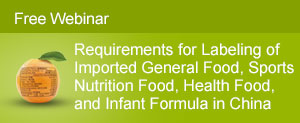In accordance with the new Food Safety Law, in case labels and specifications of the food and food addictives are defective yet will not affect the food safety or mislead customers, food and drug administrations at or above the county level are authorized to order relevant enterprises to make corrections; in case enterprises refuse to make corrections, penalty of less than 1000 RMB can be imposed on the enterprises.
The above article shows that the government displays a certain tolerance for label defects. The penalty for label defects is neither too high nor too low. As a result, enterprises may not face severe damages when label defects occur in their labels.
Then, what are label defects?
Pursuant to the Food Safety Law, there are two preconditions for the recognition of label defects.
The above article shows that the government displays a certain tolerance for label defects. The penalty for label defects is neither too high nor too low. As a result, enterprises may not face severe damages when label defects occur in their labels.
Then, what are label defects?
Pursuant to the Food Safety Law, there are two preconditions for the recognition of label defects.
- Unaffect to the “food safety”;
-----CIRS comment on food safety: the food shall meet requirements of laws, regulations and standards. The food itself has no safety issues and it will not do harm to the health and safety of customers.
- Will not mislead customers
------CIRS comment on “mislead”: functions are overstated, the concepts and name of the products are misleading, or it is easy for customers to mix the food products up with other products; other descriptions that cannot reflect the nature of the food products.
Is there any specific definition of label defects under current laws and regulations?
Pursuant to the Implementation Rules for Food Safety Law (draft for public comment), the following case is considered as label defects: Non-substantial contents of the food safety labels and specifications, such as the character pitch, font size, punctuations, the use of simplified and traditional Chinese and rounding interval are found not in conformity with rules and regulations, which will not affect the food safety and will not mislead customers.
As is seen in the above draft, there is not much information concerning the definition of label defects. We still cannot know whether the definition of label defects will be enlarged in the formal version. Except for the above-mentioned contents, no other information with regard to label defects is released by the State.
However, after the new Food Safety Law came into force, Beijing Food and Drug Administration released a Guideline for the guidance of relevant cases. The Guideline also lists ten circumstances that belong to label defects. Although this Guideline is only applicable in Beijing, it still can be used as a reference as there is no other explicit regulation released by the State.
Labels may be considered as defective in the following ten circumstances:
Is there any specific definition of label defects under current laws and regulations?
Pursuant to the Implementation Rules for Food Safety Law (draft for public comment), the following case is considered as label defects: Non-substantial contents of the food safety labels and specifications, such as the character pitch, font size, punctuations, the use of simplified and traditional Chinese and rounding interval are found not in conformity with rules and regulations, which will not affect the food safety and will not mislead customers.
As is seen in the above draft, there is not much information concerning the definition of label defects. We still cannot know whether the definition of label defects will be enlarged in the formal version. Except for the above-mentioned contents, no other information with regard to label defects is released by the State.
However, after the new Food Safety Law came into force, Beijing Food and Drug Administration released a Guideline for the guidance of relevant cases. The Guideline also lists ten circumstances that belong to label defects. Although this Guideline is only applicable in Beijing, it still can be used as a reference as there is no other explicit regulation released by the State.
Labels may be considered as defective in the following ten circumstances:
| SN | Situation | Example |
| 1 | The word on the label is misspelling, but it doesn’t lead to comprehension errors. | “营养成分”is written as“营养成份”。 |
| 2 | Use Traditional Chinese on the label, but it doesn’t lead to comprehension errors. | “蛋白质”is written as“蛋白貭”。 |
| 3 | The use of punctuation on the label is not standardized, but it doesn’t lead to comprehension errors. | ”GB7718-2011”, which is “Food Safety Nation Standard for General Rules on the labeling of Pre-packaged food”, is written as “GB7718’/2011” |
| 4 | The values of nutrients in the nutrition information table meet the test standards, but the rounding interval is not standardized. | The food nutrition information table indicates “energy 935.2 kJ, protein 4.12 kg, saturated fatty acid 14 g, sodium 34.5 mg”. According to “GB28050-2011”, energy, protein, saturated fatty acid and sodium should be rounded off to 1, 0.1, 0.1 and 1, so above-mentioned label is defective. The correct nutrition information table shall be “energy 935 kJ, protein 4.1 kg, saturated fatty acid 14.0 g, sodium 35 mg”. |
| 5 | The unit used in nutrition information table is not standardized, but it doesn’t lead to comprehension errors. |
The unit of “energy” in nutrition information table is “KJ” while the Standard requires using “kJ” on the label. |
| 6 | The date of manufacture and valid date are shown as “see package”, but are not indicated in the certain part. | “Date of manufacture can be found at the bottom of package” is marked on pre-package food label, but the manufacture date is indicated on the top of package actually. |
| 7 | The height of word, punctuation and number for mandatory labeling information (e g. Net weight) is lower than standard and the size of foreign word is larger than Chinese. But these situations do not lead to comprehension errors. | - |
| 8 | Expression method and format are not standardized. | “1 kg” is written as “1000 g”. |
| 9 | Select 3 allowed types to express different food additives on the label at the same time. | Food additives: propylene ester of fatty acids (chemical name of food additives); thickener (407,412) (functional category name and INS code of food additive); colorant (annatto)(functional category name and chemical name of food additives) |
| 10 | The translation on the domestic food label is incorrect, but it doesn’t lead to comprehension errors. | - |
Contact us
Ms. Wing Yu, CIRS Food Safety and Regulatory Department
11F Dongguan Building, 288 Qiuyi Road, Binjiang District, Hangzhou, China, 310020
Tel: +86 571 8720 6538 | Fax: +86 571 8720 6533
Email: Wing.Yu@cirs-group.com






